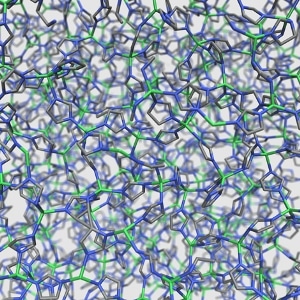Dec 22 2016
 A disordered hybrid organic-inorganic porous material. Credit: © François-Xavier Coudert, CNRS.
A disordered hybrid organic-inorganic porous material. Credit: © François-Xavier Coudert, CNRS.
Hybrid organic-inorganic materials are primarily known for their extreme porosity. These materials were developed almost 20 years ago by Gérard Férey, laureate of the CNRS 2010 Gold Medal, and his team. This remarkable feature provides a wide range of applications in the fields of sustainable development, health, and energy.
Researchers from the Institut de recherche de chimie Paris (CNRS/Chimie ParisTech) and Cambridge University have conducted an inventory of research to date. Unexpected new properties for these materials were revealed by the research work. The increasing defects in their crystalline structure resulted in greater performance. The research was featured in the December 20 issue of Nature Chemistry.
Hybrid organic-inorganic materials, considered to be highly porous crystalline structures, have an internal surface that is capable of representing more than 6,000 m2 per gram. This enables the materials to immobilize an increasing number of molecules, for example, they are used as adsorbents in the capture of carbon dioxide.
These materials are considered to be exceptional catalysts for several chemical reactions because of the variety of their composition and structure. The complex supramolecular assembly of these materials is extremely fascinating, and in recent years, chemists from all over the world have been focusing on synthesizing as many as possible.
Until now, more that 15,000 structures have been developed. However, the detailed physical properties of only a few of these structures are known, and only around ten are presently available on the market.
An inventory has been established by researchers from the CNRS and Cambridge University in order to become more familiar with their properties. The research conducted by the team revealed a counterintuitive and surprising phenomenon: flexibility, molecular disorder, and defects in the crystalline organization provide these materials with positive features.
Even though hybrid organic-inorganic materials are often considered to be rigid crystalline structures, the team highlights that these materials possess high large-scale flexibility, which is frequently coupled with their defects. In other cases, these imperfections existing in the crystalline network increase their ability to capture or to catalyze carbon dioxide.
This research should make room to discover new applications for these materials based on their properties and requirements of the researchers.